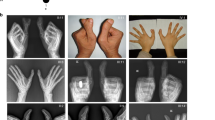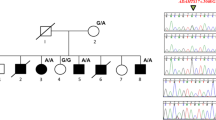Abstract
Brachydactyly type A-1 (BDA-1; MIM 112500) is characterized by shortening or missing of the middle phalanges (Fig. 1a)1. It was first identified by Farabee in 1903 (ref. 2), is the first recorded example of a human anomaly with Mendelian autosomal-dominant inheritance and, as such, is cited in most genetic and biological textbooks. Here we show that mutations in IHH, which encodes Indian hedgehog, cause BDA-1. We have identified three heterozygous missense mutations in the region encoding the amino-terminal signaling domain in all affected members of three large, unrelated families. The three mutant amino acids, which are conserved across all vertebrates and invertebrates studied so far, are predicted to be adjacent on the surface of IHH.

a, The hands and feet of an affected individual in family III. In some affected individuals all middle phalanges are missing or fused to the distal phalanges; in others, one to three fingers or toes have missing or fused phalanges. b, Affected individual with two children (the affected child is on the right) in family III. Note short stature. c, BDA-1 pedigrees I, II and III; affected individuals are denoted by filled symbols.
This is a preview of subscription content, access via your institution
Access options
Subscribe to this journal
Receive 12 print issues and online access
$209.00 per year
only $17.42 per issue
Buy this article
- Purchase on Springer Link
- Instant access to full article PDF
Prices may be subject to local taxes which are calculated during checkout



Similar content being viewed by others
References
Bell, J. in Treasury of Human Inheritance Vol. 5 (ed. Penrose, L.S.) 1–31 (Cambridge University Press, London, 1951).
Farabee, W.C. Hereditary and Sexual Influence in Meristic Variation: A Study of Digital Malformations in Man. Thesis, Harvard University (1903).
Fitch, N. Classification and identification of inherited brachydactylies. J. Med. Genet. 16, 36–44 (1979).
Weinstein, L.S. et al. Mutation of the Gs alpha-subunit gene in Albright hereditary osteodystrophy detected by denaturing gradient gel electrophoresis. Proc. Natl. Acad. Sci. USA 87, 8287–8290 (1990).
Polinkovsky, A. et al. Mutations in CDMP1 cause autosomal dominant brachydactyly type C. Nature Genet. 17, 18–19 (1997).
Oldridge, M. et al. Dominant mutations in ROR2, encoding an orphan receptor tyrosine kinase, cause brachydactyly type B. Nature Genet. 24, 275–278 (2000).
Yang, X. et al. A locus for brachydactyly type A-1 maps to chromosome 2q35–q36. Am. J. Hum. Genet. 66, 892–903 (2000).
Vortkamp, A. et al. Regulation of rate of cartilage differentiation by Indian hedgehog and PTH-related protein. Science 273, 613–622 (1996).
Roessler, E. et al. Mutations in the human Sonic Hedgehog gene cause holoprosencephaly. Nature Genet. 14, 357–360 (1996).
Hammerschmidt, M., Brook, A. & McMahon, A.P. The world according to hedgehog. Trends Genet. 13, 14–21 (1997).
Porter, J.A. et al. The product of hedgehog autoproteolytic cleavage active in local and long-range signalling. Nature 374, 363–366 (1995).
Capdevila, J. & Johnson, R.L. Hedgehog signaling in vertebrate and invertebrate limb patterning. Cell. Mol. Life Sci. 57, 1682–1694 (2000).
Bosse, K. et al. Localization of a gene for syndactyly type 1 to chromosome 2q34–q36. Am. J. Hum. Genet. 67, 492–497 (2000).
Hall, T.M., Porter, J.A., Beachy, P.A. & Leahy, D.J. A potential catalytic site revealed by the 1.7-Å crystal structure of the amino-terminal signalling domain of Sonic hedgehog. Nature 378, 212–216 (1995).
Naoyuki, F. et al. Sonic hedgehog protein signals not as a hydrolytic enzyme but as an apparent ligand for Patched. Proc. Natl. Acad. Sci. USA. 96, 10992–10999 (1999).
Pepinsky R.B. et al. Mapping Sonic Hedgehog-receptor interactions by steric interference. J. Biol. Chem. 275, 10995–11001 (2000).
Stone, D.M. et al. The tumor-suppressor gene patched encodes a candidate receptor for Sonic hedgehog. Nature 384, 129–134 (1996).
Marigo, V., Davery, R.A., Zuo, Y., Cunningham, J.M. & Tabin, C.J. Biochemical evidence that Patched is the Hedgehog receptor. Nature 384, 176–179 (1996).
Carpenter, D. et al. Characterization of two patched receptors for the vertebrate hedgehog protein family. Proc. Natl. Acad. Sci. USA. 95, 13630–13634 (1998).
Chuang, P.T. & McMahon, A.P. Vertebrate Hedgehog signalling modulated by induction of a Hedgehog-binding protein. Nature 397, 617–621 (1999).
St-Jacques, B., Hammerschmidt, M. & McMahon, A.P. Indian hedgehog signaling regulates proliferation and differentiation of chondrocytes and is essential for bone formation. Genes Dev. 13, 2072–2086 (1999).
Villavicencio, E.H., Walterhouse, D.O. & Iannaccone, P.M. The Sonic Hedgehog-Patched-Gli pathway in human development and disease. Am. J. Hum. Genet. 67, 1047–1054 (2000).
Acknowledgements
We thank Shanghai Jiao Tong University, Chinese Academy of Sciences, The Chinese National Human Genome Center at Shanghai, the Science & Technology Commission of Shanghai Municipality, the National Natural Science Foundation of China, the Unilever Co. Ltd. and the National 973 projects for generous financial support.
Author information
Authors and Affiliations
Corresponding author
Rights and permissions
About this article
Cite this article
Gao, B., Guo, J., She, C. et al. Mutations in IHH, encoding Indian hedgehog, cause brachydactyly type A-1. Nat Genet 28, 386–388 (2001). https://doi.org/10.1038/ng577
Received:
Accepted:
Published:
Issue Date:
DOI: https://doi.org/10.1038/ng577
This article is cited by
-
Suppression of apoptosis impairs phalangeal joint formation in the pathogenesis of brachydactyly type A1
Nature Communications (2024)
-
A novel variant in the ROR2 gene underlying brachydactyly type B: a case report
BMC Pediatrics (2022)
-
The molecular genetics of human appendicular skeleton
Molecular Genetics and Genomics (2022)
-
Inactivation of Ihh in Sp7-Expressing Cells Inhibits Osteoblast Proliferation, Differentiation, and Bone Formation, Resulting in a Dwarfism Phenotype with Severe Skeletal Dysplasia in Mice
Calcified Tissue International (2022)
-
A novel variant of IHH in a Chinese family with brachydactyly type 1
BMC Medical Genetics (2020)



